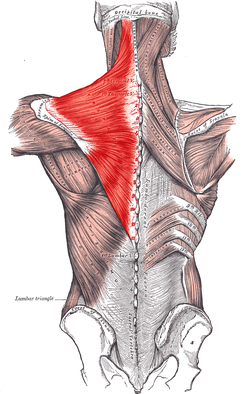| Trapezius | |
|---|---|
 The trapezius muscle (pl.: trapezii) is a surface muscle of back, shown in red above and below. | |
 | |
| Details | |
| Origin | Medial one-third of superior nuchal line, external occipital protuberance, spinous processes of vertebrae C7-T12, Nuchal ligament[1] |
| Insertion | Posterior border of the lateral one-third of the clavicle, acromion process, and spine of scapula |
| Artery | Superficial branch of transverse cervical artery or superficial cervical artery [2] |
| Nerve | Accessory nerve (motor) cervical spinal nerves C3 and C4 (motor and sensation)[3] |
| Actions | Rotation, retraction, elevation, and depression of scapula |
| Antagonist | Serratus anterior muscle, latissimus dorsi, pectoralis major |
| Identifiers | |
| Latin | musculus trapezius |
| TA98 | A04.3.01.001 |
| TA2 | 2226 |
| FMA | 9626 |
| Anatomical terms of muscle | |
The trapezius[4] is a large paired trapezoid-shaped surface muscle that extends longitudinally from the occipital bone to the lower thoracic vertebrae of the spine and laterally to the spine of the scapula. It moves the scapula and supports the arm.
The trapezius has three functional parts:
- an upper (descending) part which supports the weight of the arm;
- a middle region (transverse), which retracts the scapula; and
- a lower (ascending) part which medially rotates and depresses the scapula.
- ^ Rockwood, Charles A. (January 1, 2009). The Shoulder. ISBN 978-1416034278.
- ^ "Tufts". Archived from the original on April 22, 2003. Retrieved December 11, 2007.
- ^ Dalley, Arthur F.; Moore, Keith L.; Agur, Anne M.R. (2010). Clinically oriented anatomy (6th [International] ed.). Philadelphia [etc.]: Lippincott Williams & Wilkins, Wolters Kluwer. p. 700. ISBN 978-1-60547-652-0.
- ^ Lajtai, Georg; Applegate, Gregory; Snyder, Stephen J.; Aitzetmüller, Gernot; Gerber, Christian (March 11, 2003). "trapezoid"&pg=PA89 Shoulder Arthroscopy and MRI Techniques: 20 Tables. ISBN 9783540431121.